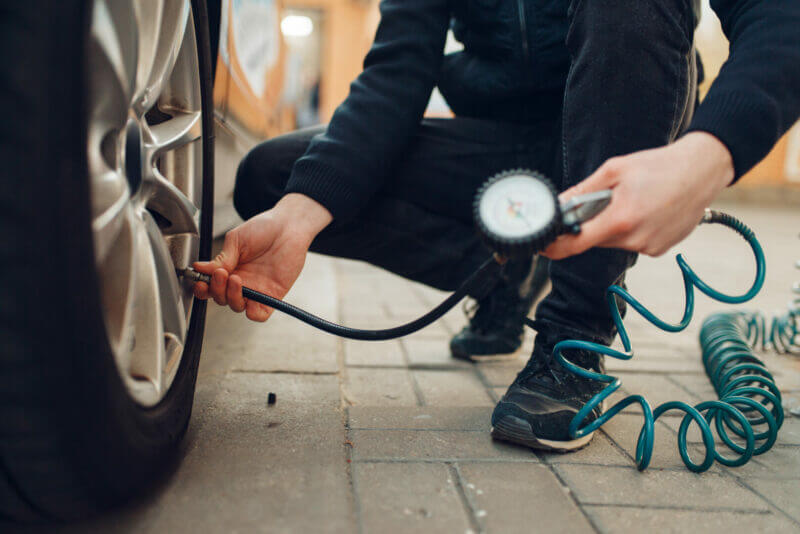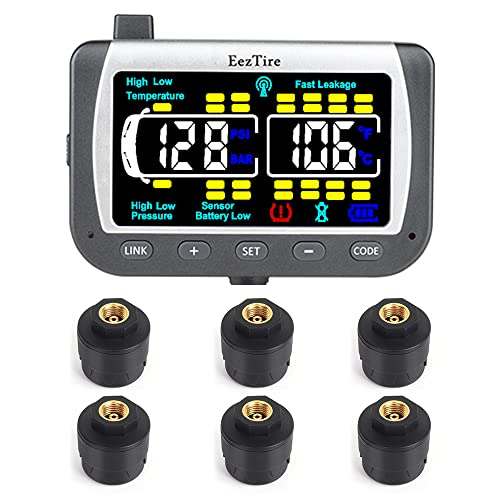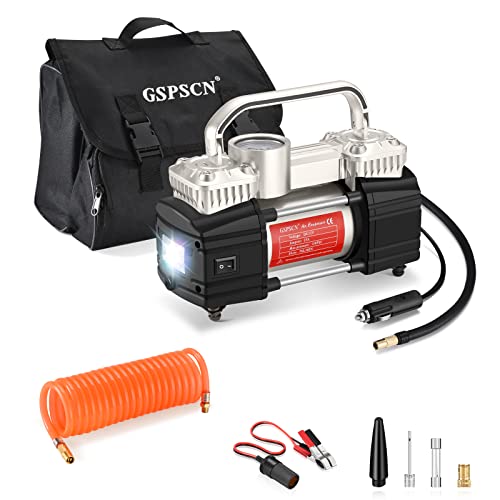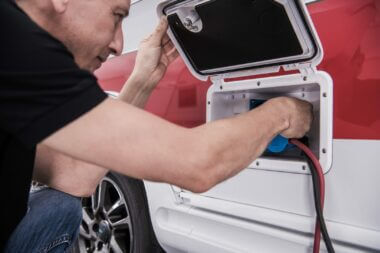Table of Contents Show
When was the last time you checked your RV tire pressure? It could be really dangerous to continue traveling down the highway with too high or too low RV tire pressure!
If you want to avoid a possible blowout and damage to your RV, keep an eye on your RV tire pressure. Knowing your tire pressure and how to set it is essential for a successful and safe RVing trip.
Let’s take a look!
What Should Your RV Tire Pressure Be?
An RV’s tire pressure will vary from one RV to the next. There are multiple factors to consider when knowing what your RV tire pressure should be. Let’s look at several steps for calculating your ideal RV tire pressure.
#1. Find Your Vehicle and Axle Weight Ratings
Your RV will likely come with a sticker that lists the carrying capacity and axle weight ratings. Knowing your vehicle and axle weight ratings allows you to determine how much weight you can add to your RV. Exceeding your vehicle and axle weight ratings can void your warranty, lead to expensive repairs, and accelerate the wear and tear on your RV.
#2. Load Your RV to Its Traveling Weight
When you’re RVing, it’s not just the weight of your RV that your tires are carrying. Your RV tires will also carry the contents of your RV. Every time you store anything in your RV, it adds weight to your tires. This added weight includes camping gear, water in your fresh or waste tanks, or upgrades like solar panels.
Load up your RV with anything you would take with you while using it. If you typically travel in your RV with water in your freshwater tank, fill up your tank. You want to have your RV as close to travel-ready as possible when you weigh it.
#3. Weigh Your RV
Once you have your RV loaded up and ready to go, weigh it. The easiest way to weigh your RV is to locate the nearest CAT scale. These scales are typically at truck stops or other large fuel stations.
Pull up to the CAT scale and make sure you have one axle on each of the plates. Once you’re on the plates, all you have to do is follow the instructions posted on the scale. Many RVers take advantage of the CAT scale mobile phone app that allows users to do all of the weighings from their phone. Using a CAT scale will come with a fee, typically $12.50 for your first weighing, $3.00 for a reweigh, and a maximum of $21.50 in 24 hours.
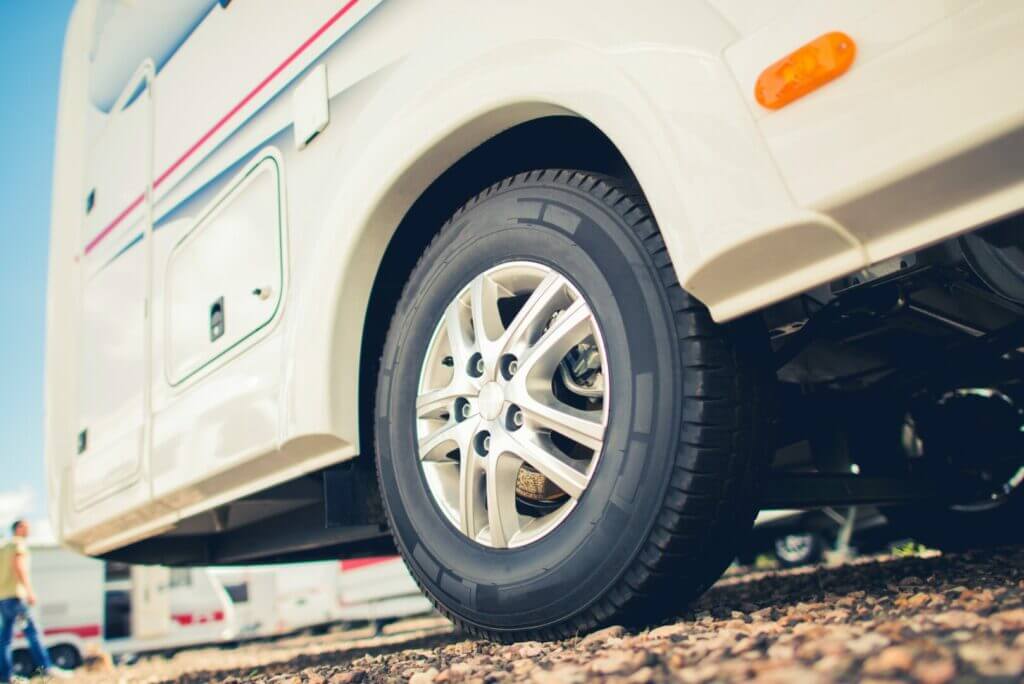
#4. Compare Your Weights to the Manufacturer Ratings
Now that you have your unique numbers compare them with the ratings provided by the manufacturer. Doing so will help you to know if you need to subtract weight from your RV or if you have room for that new piece of camping gear you’ve had sitting in your Amazon shopping cart.
It’s important to stay under all manufacturer ratings. While your RV may handle carrying extra weight, the manufacturer has these ratings for a purpose. They help extend the life of your RV and create the safest possible RVing scenario. Overloading your RV can lead to an unsafe situation for you, your passengers, and others on the road.
#5. Find the Inflation Tables for Your Tires
Tire manufacturers like Goodyear, Sailun, and Hercules release inflation tables for their tires. Locate the inflation table for the tires on your RV. A quick search on the internet for your brand of tires, including the model number and tire size, can get you to the right table.
#6. Determine Your Tire Pressure
The final step is to look for the tire load capacity that matches your tire. You’ll finally be able to see the recommended tire pressure for your RV. Every tire on the axles should be at the same tire pressure. This lets you equally distribute the weight of your RV and its contents.
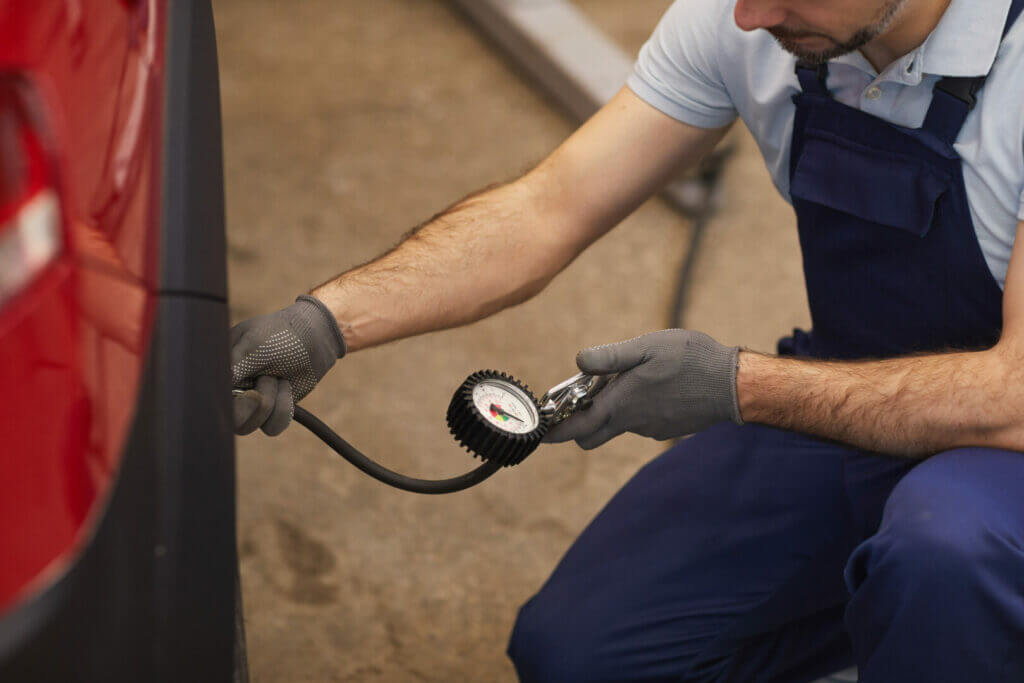
How to Set Your Tire Pressure
Now that you know your ideal RV tire pressure, you can check and adjust your tire pressure accordingly. Let’s look at how!
#1. Do It Yourself
If you have the proper tools, you can do it from your driveway or possibly even your campsite. Setting your tire pressure isn’t a job that requires a professional, but if you want to trust a professional to do it, they can.
Pro Tip: If you’re looking for the overall best air compressors, check out the 5 Best Air Compressors for Your RV Tires.
#2. Go to a Tire Shop
Most places that sell tires will also gladly set your tire pressure. There may be a nominal fee involved. Depending on the size of your RV, it may be challenging to maneuver your RV into a tire shop’s parking lot. If you can’t adjust your tire pressure yourself, you should always verify that the tire shop can accommodate your RV before driving to them.
When Should You Check Your RV Tire Pressure?
You should check your RV tire pressure before every trip. Driving even short distances with tires with low pressure can cause excessive heat and lead to a blowout. A blowout can damage your RV and cost you a pretty penny.
Many RVers also check their RV tire pressure whenever they stop to fuel up or use the restroom. Monitoring your RV tires and looking for any signs of irregularities is vital to avoid issues. And this may be a good habit to start so that you remember to check your tire pressure before it’s too late.
If you know you will forget no matter what, you’re in luck. A tire pressure monitoring system is also an important piece of equipment that RVers use. This system allows RVers to monitor the tire pressure of their RV and pull over at the first sign of an issue.
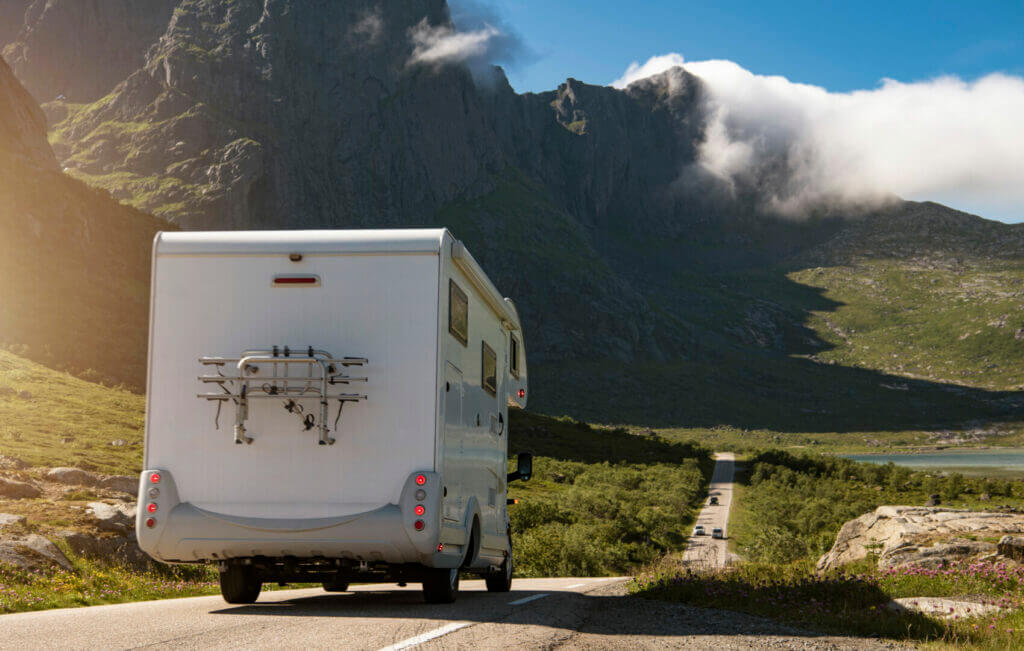
What Tools Should You Have to Check Your Tires?
To help you set your RV tire pressure, there are a few tools you’ll need. Let’s look at a handful of these important tools you should make sure you have with you while RVing.
Tire Inflator
- ADVANCED ACCURACY: Professionally calibrated to always return an accurate reading within 1% of the exact pressure of...
- ALL-IN-ONE FEATURES: The LED backlit screen features measurements in PSI, KPA, Bar, and Kg/cm^2; Includes an inflator,...
Why It’s Helpful: A tire inflator will allow you to quickly and easily connect an air compressor pump to your tire’s valve stems. Many of these sets will also allow you to adjust the tire pressure and see the current pressure. This feature makes it simple to adjust your RV tire pressure.
Valve Stem Extenders
- 3 Kinds Of Degrees : The valve extenders have 3 kind of angles, 45 degree, 90 degree and 135 degree, and they are all...
- Superior Quality : The tyre valve extension adaptor is made of brass, chrome plated on the surface, comes with metal...
Why It’s Helpful: You’ll check and adjust your tire pressure using the valve stems on your tires. Some vehicles, especially dually trucks, make this tough, however. Valve extenders can simplify the process. Don’t struggle through a task that should be quick and easy in the first place.
Tire Pressure Monitoring System
- REAL TIME/24x7 SAFETY & HIGH FUEL ECONOMY - EezTire TPMS system by EEZ RV Products is the industry leader in the RV TPMS...
- ADVANCED TECHNOLOGY ALERT SYSTEM - the monitor is motion sensitive and monitors tire pressure and temperature on...
Why It’s Helpful: Knowing your tire pressure before you hit the road is important, but you also have to monitor it on the road. A quality tire pressure monitoring system allows you to monitor the tire pressure while traveling. These systems will alert you to sudden changes in tire pressure or if your tires get outside of pre-selected parameters.
These alerts can save your day. Many RVers can attest to how receiving an alert caused them to pull over. Had they not pulled over to a safe spot, the tire could have likely blown out.
Air Compressor Pump
- FAST INFLATION : maximum pressure 150PSI, air flow 2.12CFM, inflates standard vehicle tire in 1.5 minutes (195/65/R16,...
- BRIGHT LED LIGHT : GSPSCN portable 12v air compressor is equipped with bright and long-lasting LED lights, allow easy...
Why It’s Helpful: Having a tire inflator with you at all times while RVing is vital in emergencies. Verify that the tire inflator can fill tires to the recommended pressure for your RV. Some cheaper inflators are for smaller vehicles that require lower pressure than RVs. As a bonus, a tire inflator is great for filling up bike tires, balls, and other inflatable toys. It’s a great multi-purpose tool that can save the day in more ways than one.
The safety of you, your passengers, and others on the road is worth the effort of not only researching your tire pressure but making sure your pressure is set before each trip. Don’t put anyone at risk by not keeping your tire pressure on your mind while RVing. How often do you check your tire pressure?
Last update on 2025-01-19 / Affiliate links / Images from Amazon Product Advertising API




